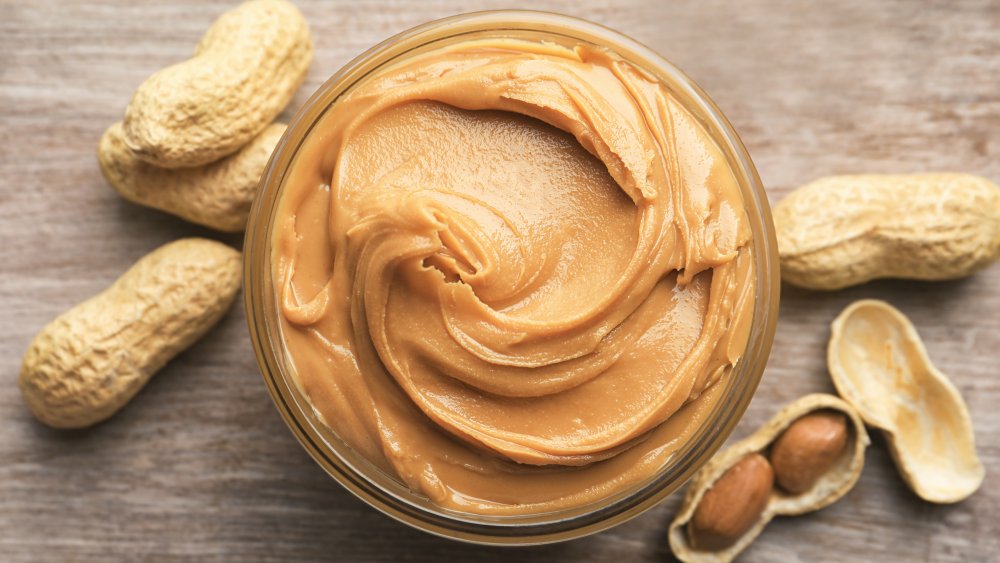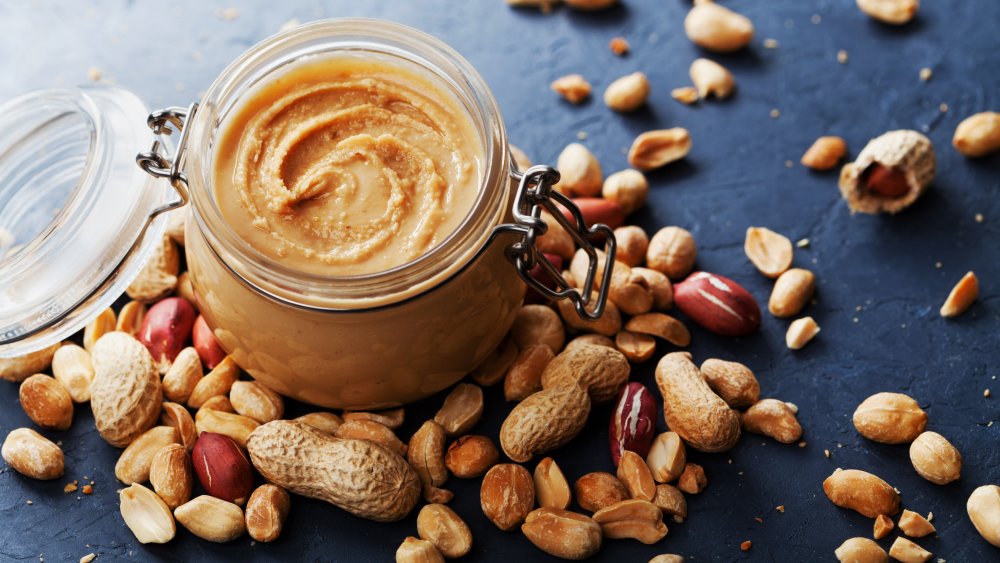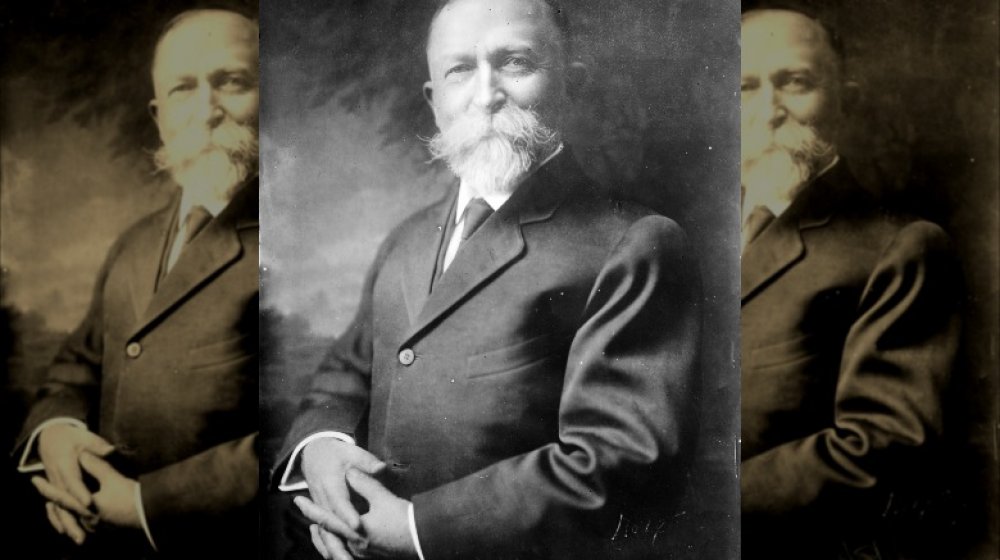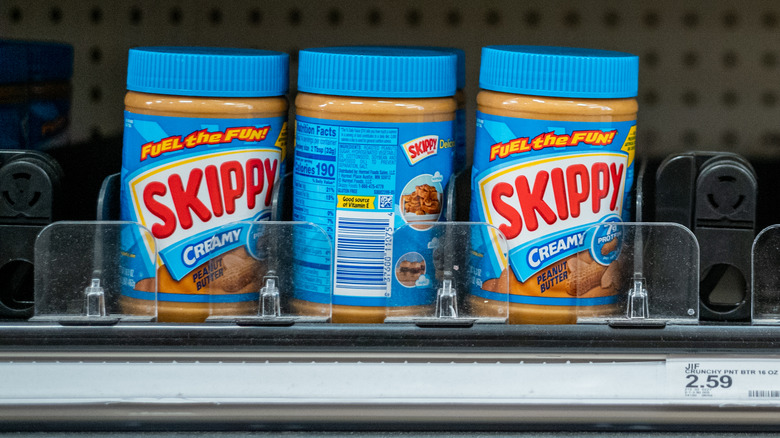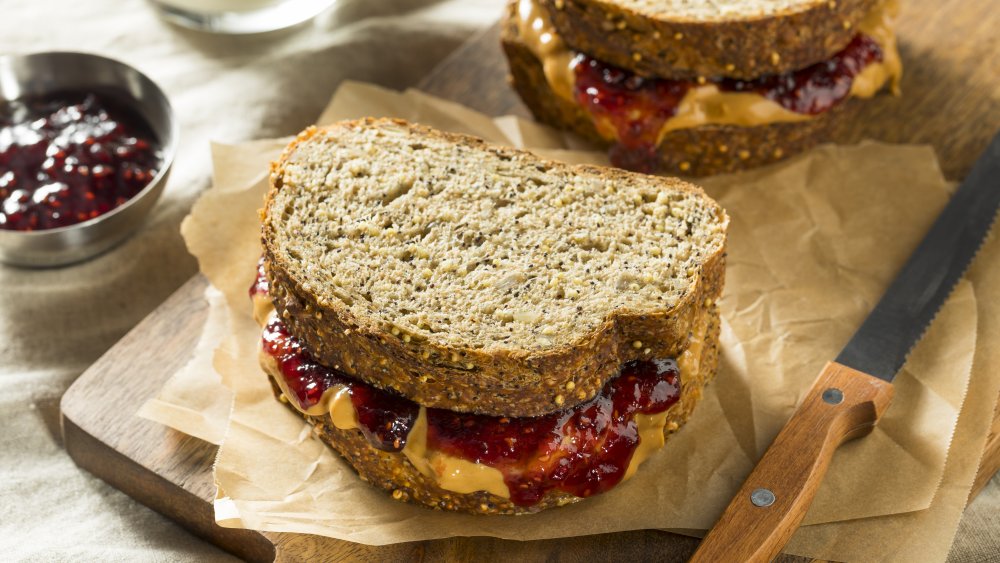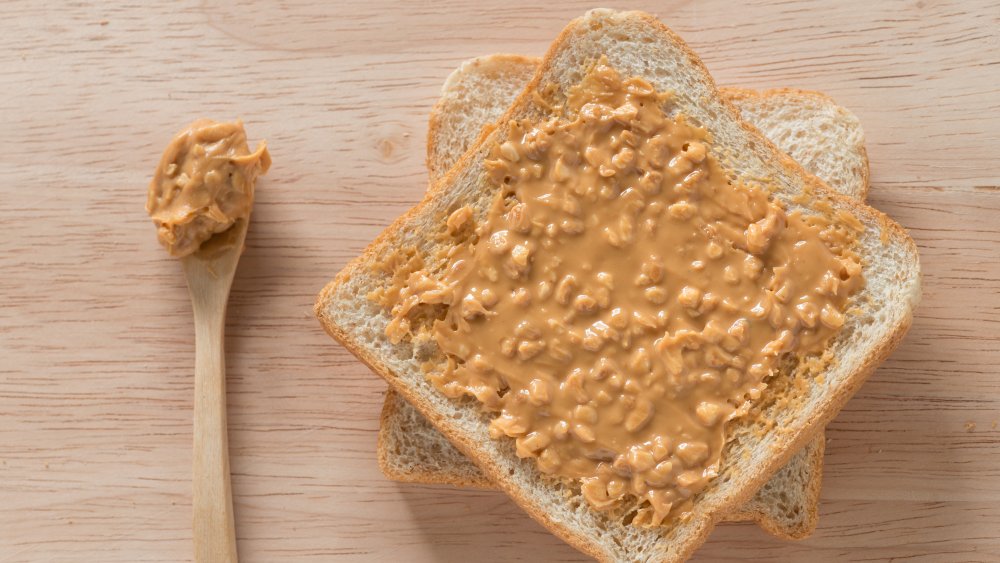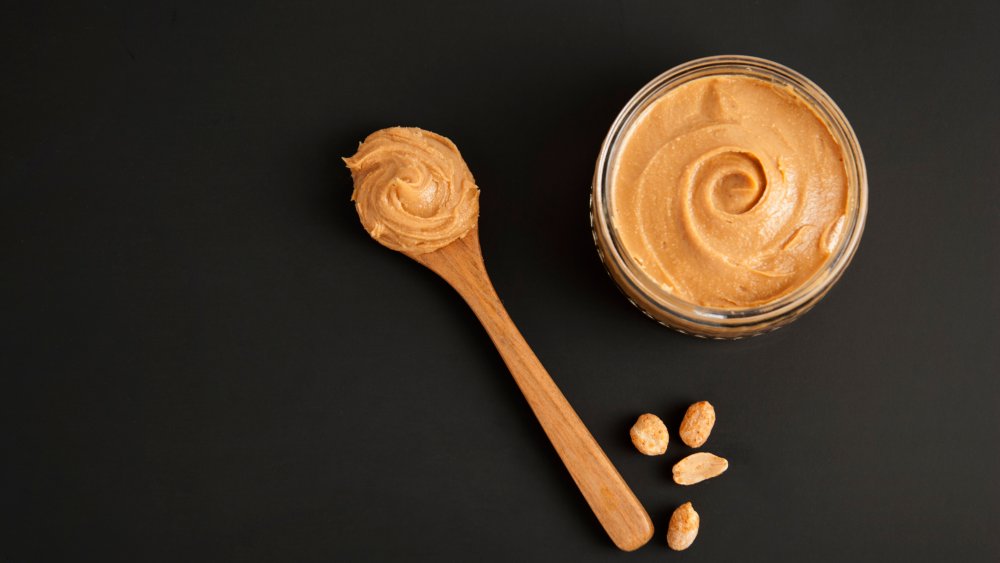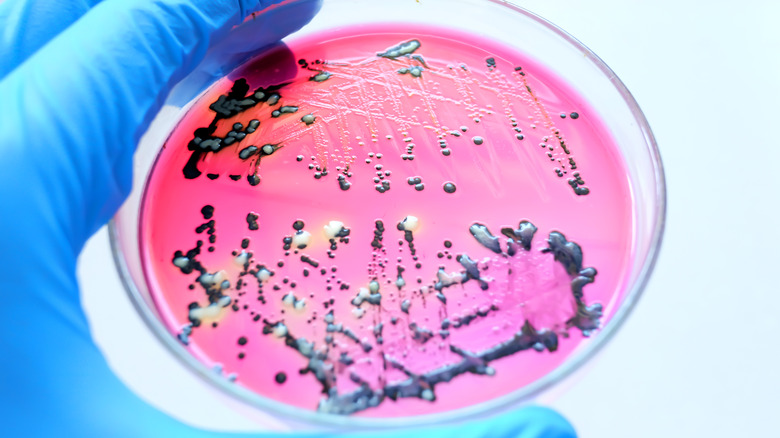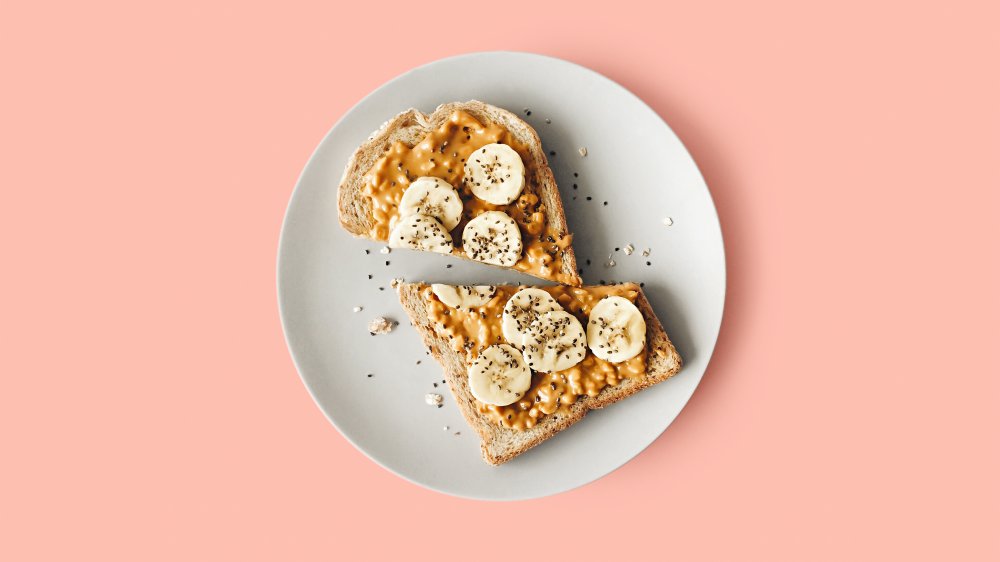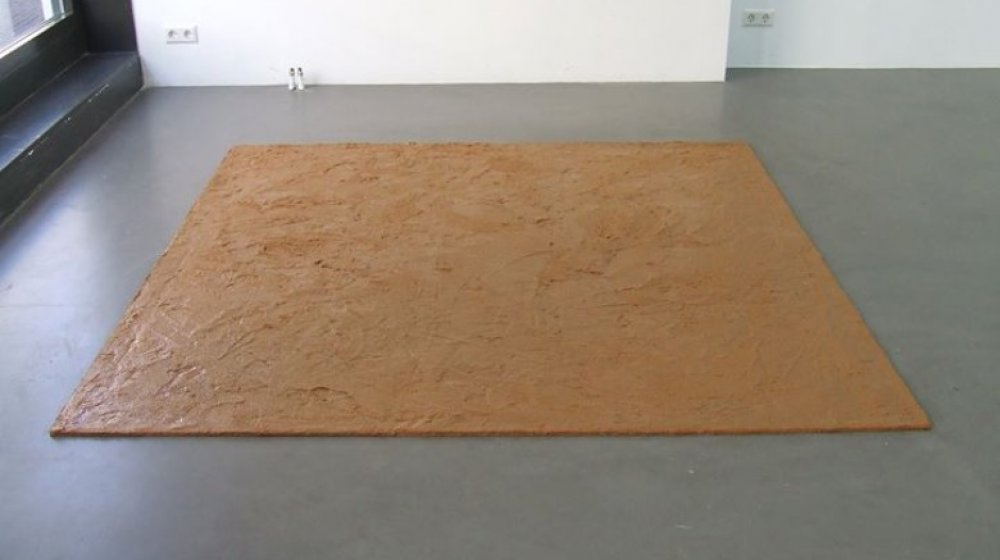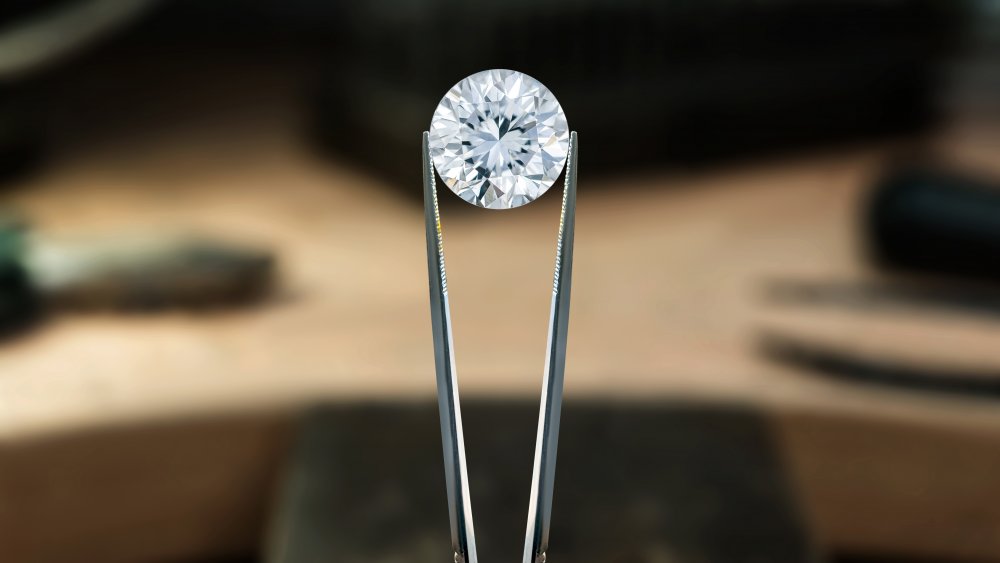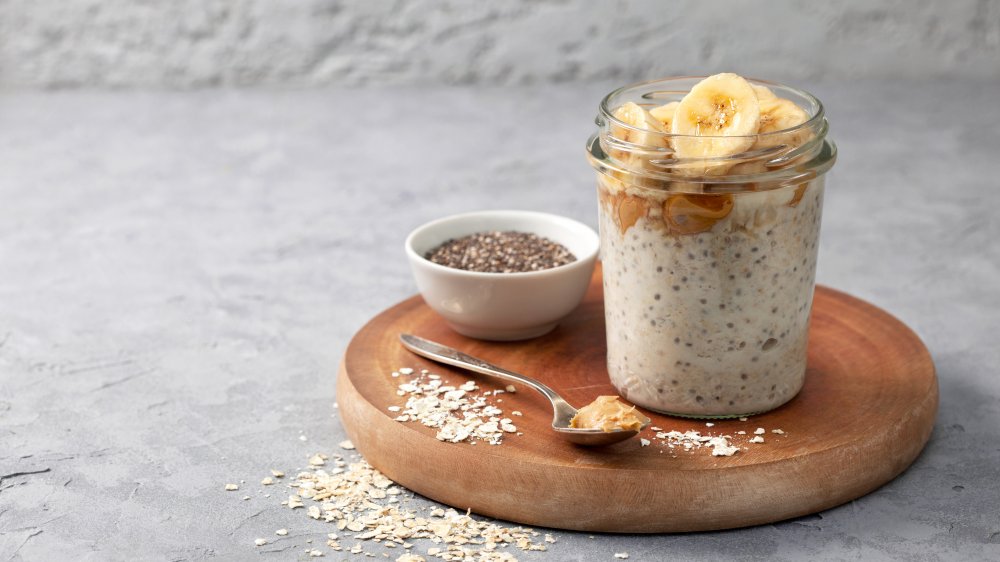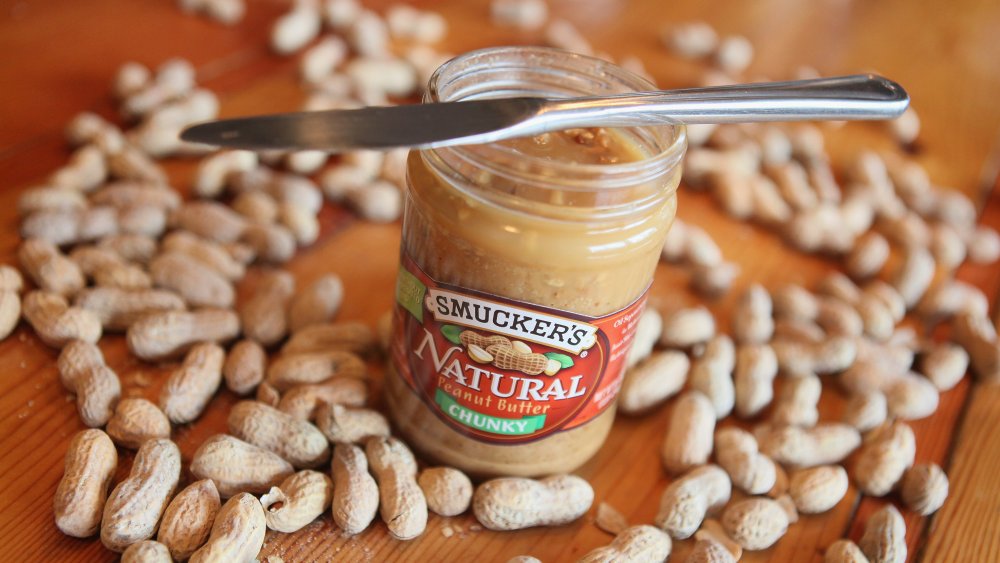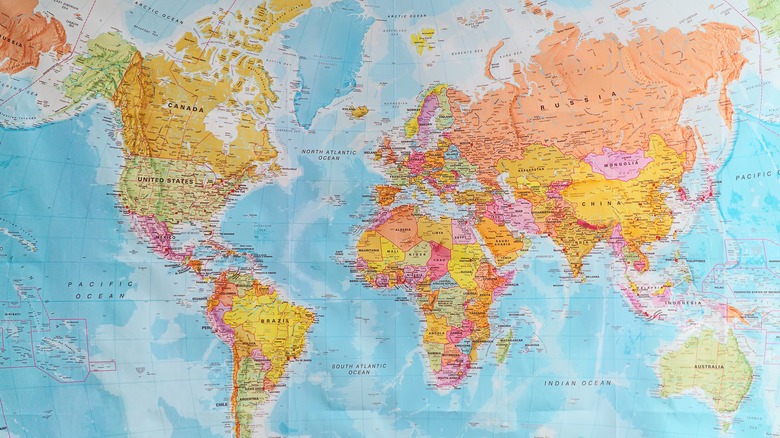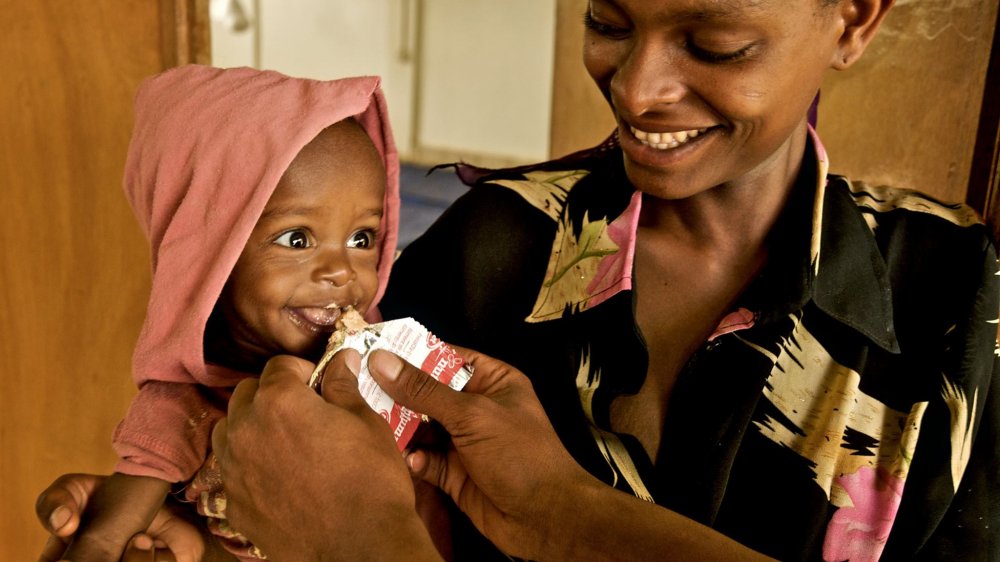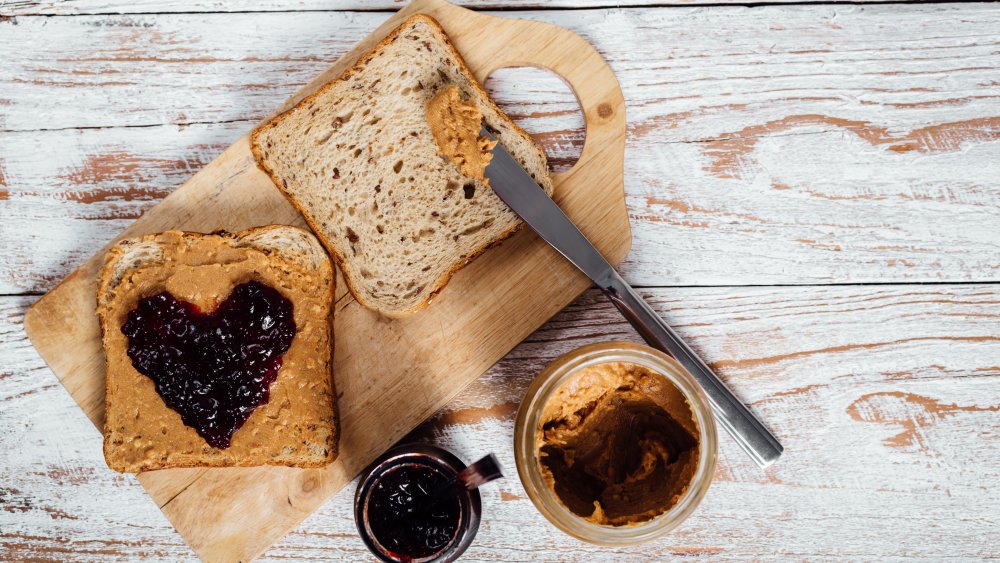Peanut Butter: 15 Facts You Should Know About The Sandwich Staple
Peanut butter. It's the stuff of childhood lunches, it's in the most delicious desserts in your repertoire, and let's all be honest here, right from the start: There are days where you just need to eat a spoonful right from the jar, it's so darn good. It's sticky and filling and salty, and it's pretty much perfect when you pair it with chocolate, right?
But how much do you really know about it? It was invented by George Washington Carver, you've heard ... and we'll stop you right there because that's just not true.
It turns out there's a lot of things you might not know about this pantry and snacking staple, and don't worry, we'll give you the good news right up front: There's nothing in here that's going to make you think twice before reaching for the jar next time. And how many foods can you say that about? So pull up a seat, and let's talk about the untold truth of peanut butter.
1. No, peanut butter wasn't invented by George Washington Carver
We've all heard that peanut butter was invented by George Washington Carver, and it makes sense. According to the National Peanut Board, he's pretty much known as the father of the modern peanut industry, and he's credited with discovering more than 300 uses for peanuts. Those include some other food items — like chili sauce — and some not-so-edible products (like glue and shaving cream), but oddly ... not peanut butter.
The general idea of peanut butter goes a long way back — all the way to the Aztecs, who used to grind roasted peanuts into a paste. It wasn't quite the same idea as today's peanut butter, which we need to thank three people for.
First, there's Canada's Marcellus Gilmore Edson, who patented the process for making "peanut paste" in 1884. Then, Dr. John Harvey Kellogg patented another process for making peanut butter from raw nuts. Finally, in 1903, Dr. Ambrose Straub patented his own invention: a machine for making peanut butter. It really was a group effort.
2. Peanut butter was made popular as a health food
Today, we don't really think of peanut butter first when we think of something healthy, but according to ThoughtCo., Dr. John Harvey Kellogg's relentless promotion of peanut butter as a health food is why it originally got as popular as it did. Kellogg's promotion of peanut butter started at the Battle Creek Sanitarium, and to give you an idea of how important this place was, PBS notes that clients included people like Thomas Edison, John D. Rockefeller, Booker T. Washington, and Amelia Earhart. Think chandeliers, banana trees in Michigan, and five acres of marble floors, and you've got the idea.
Thousands upon thousands of people flocked to the sanitarium in hopes of curing any number of ailments, and Kellogg firmly believed that cleanliness and diet were a huge part of their continued health. And that? That included a version of peanut butter that used steamed peanuts instead of roasted, so it was admittedly a little different than what we're used to. Still, it became famous as a menu staple.
Of course, not everyone could afford to head off to the San for some R&R. In 1904, the idea of peanut butter reached a mass audience, thanks to a concession stand operator named C.H. Sumner. He had a stand at the St. Louis World's Fair, and after selling $705.11 in peanut butter, it was being mass-marketed within the year. (And that $705.11? Adjusted for inflation, that's over $20,000 today.)
3. Joseph Rosefield devised a way to make peanut butter shelf stable
By the early 1900s, peanut butter was off and running as a popular food item in the United States. There was, however, a significant hurdle that prevented it from being sold in grocery stores across the country: It was not shelf stable. According to Smithsonian Magazine, peanut butter manufacturers sold their product to markets by the tub. Grocers were then forced to keep the mixture stirred so the peanuts and the oil would not split apart and go bad.
That all changed in 1921 when a man named Joseph Rosefield thought to use a chemical process on peanut butter. The method, which is similar to the one for creating Crisco, involved converting peanut butter's natural oil from a liquid into more of a solid. This change through partial hydrogenation allowed the oil to stay blended and the peanut butter to remain fresh.
Rosefield's ingenuity helped peanut butter become the household staple it is today. Without risk of spoiling, the product could be distributed nationwide, stored on grocery shelves, and brought home by hungry customers to keep in their pantries. Despite his major contribution, Rosefield wasn't done with peanut butter just yet. About a decade after introducing partial hydrogenation, he founded his very own peanut butter company. It's one you may have heard of: Skippy.
4. You'll be surprised to learn why the peanut butter and jelly sandwich is a thing
You can't get much better than a PB&J sandwich, right? It's the perfect combination of salty and sweet, and like all foods, someone had to be the first to make it. According to the National Peanut Board, there were a few things that had to come together to create this lunchtime favorite. First was Otto Frederick Rohwedder's invention for slicing bread, and next was Paul Welch's patent on the process for making grape jelly. At that time, peanut butter had been appearing on the menus of upscale New York City restaurants for a while, but it was typically paired with ingredients like watercress or pimento.
Then, in 1901, the Boston Cooking School Magazine of Culinary Science and Domestic Economics published the first recipe for a PB&J sandwich. Yes, really, a whole recipe — and in case you're wondering, recipe author Julia Davis Chandler suggested crabapple or currant jelly. The idea puttered along for a while, and then, World War II happened.
The U.S. military jumped on the peanut-butter bandwagon: It had shelf stability, portability, and a high protein content. Welch's grape jelly was already in the picture, and when American soldiers came back from overseas, their love of the humble PB&J endeared it to the nation.
5. Smooth or crunchy: What peanut butter team are you on?
It doesn't matter how much you love peanut butter, you probably have a preference: smooth or crunchy? According to Thrillist, there are pros to both sides. Crunchy peanut butter is much harder to spread, and let's be honest, crunchy lovers: How many slices of Wonder Bread have you ruined? But on the flip side, there's something more satisfying, more filling, and just tastier about crunchy PB. It's definitely more substantial, so take that, creamy!
But according to the Huffington Post, if you fall on the side of crunchy, you're in the minority. National Peanut Board surveys suggest that of the billion-odd pounds of peanut butter people eat every year, about 60 percent of people prefer to reach for the smooth stuff. It also suggests there's another divide: Men are more likely to opt for the crunchy, while the majority of women like the smooth. Legit, or no?
6. Peanut butter was the cause of one of the most scandalous food poisoning outbreaks ever
There are few foods that bring back a feeling of childhood innocence quite like peanut butter. But in 2015, a terrifying, peanut butter-related food poisoning outbreak finally came to an end with the sentencing of a peanut butter exec who had knowingly shipped out cases of peanut butter responsible for a massive salmonella outbreak.
According to The Washington Post, the outbreak happened in 2008 and 2009. By the time it was over, 714 people across dozens of states had gotten sick, and nine people were dead. It wasn't long, says NPR, before the outbreak was traced to the Peanut Corporation of America and a Georgia factory. And while there have been bigger, more widespread, and deadlier outbreaks, what mattered was that this one could have been easily prevented.
At the trial of former CEO Stewart Parnell, prosecutors offered evidence including documents and emails where Parnell — in spite of being warned that containers were "covered in dust and rat crap" and that the results of salmonella tests were unavailable — responded, "... just ship it. I can't afford to loose [sic] another customer."
On the heels of that evidence (along with the numerous health code violations the FDA discovered at the factory) Parnell was handed a 28-year prison sentence, while his brother, a former company supervisor, was also convicted, along with a plant quality control manager.
7. Salmonella has often been found in peanut butter
The Peanut Corporation of America outbreak was not the only time that mass-produced peanut butter has become contaminated with salmonella in recent years. In fact, it's happened quite a bit. In 2007, Peter Pan and Walmart's Great Value brands of peanut butter were recalled after having been found to contain salmonella (via CNBC). Most recently, in 2022, jars of contaminated Jif peanut butter were taken off the shelves after infecting 21 people across 17 states (via the Centers for Disease Control and Prevention).
All this begs an important question: why does salmonella continue to show up in peanut butter? It often starts during the manufacturing process, according to Health.com. The peanuts used to make peanut butter are commonly left in large piles, open to the elements, in between stages of cooking. It's here when the ingredient is often contaminated with salmonella. "Most cases of Salmonella in peanuts are caused by the presence of rainwater bringing feces onto the product, or animals — birds, or more likely rodents — [coming directly] into contact with the product," Darin Detwiler, a Northeastern University professor who holds a doctorate of law and policy and focuses on food safety, told Health.
Once the salmonella is in a jar of peanut butter, it's often there to stay. The food's high fat content helps salmonella to survive. Furthermore, since peanut butter is usually eaten at room temperature, there is no chance for the bacteria to be killed through the cooking process.
8. The 12-year-long Peanut Butter Case
When you open a jar of peanut butter, you expect it to be, well, mostly peanuts, right? Today, that's true: The contents of a peanut butter jar have to be at least 90 percent peanuts, or it has to be sold as "peanut spread." That wasn't always the case, though, and it took a long time for peanut butter law to get there.
Mental Floss reports that way back in 1959, the FDA discovered that some products labeled as "peanut butter" were only about 75 percent peanuts. The rest of the ingredients were ingredients like oils and glycerin, which were basically cheap fillers used to increase profits. The same year, the FDA proposed an across-the-board standard that said peanut butter had to be 95 percent peanuts, but manufacturers? They hated the idea and claimed people didn't want that many peanuts because it would make the product hard to spread.
What kicked off, claims Atlas Obscura, was a court case that lasted a ridiculously long 12 years. Five years after it started, manufacturers and the FDA still couldn't come to an agreement, and they turned to the public. We all know how well that always works out. Thanks in large part to the determination of Ruth Desmond, an outspoken activist and head of the Federation of Homemakers, manufacturers eventually gave in, and there are now a lot more peanuts in your peanut butter.
9. Peanut butter is the subject of a very weird art installation
Beauty might be in the eye of the beholder, but art? Art can be downright strange, especially when it involves peanut butter.
In 2010, the Museum Boijmans Van Beuningen secured the "Peanut-Butter Platform" (1962) from an artist named Wim T. Schippers. It went on display in 2011, and what exactly was it? Exactly what it sounds like — a giant rectangular patch of peanut butter on the floor. It's no small bit of peanut butter, either — according to The Courier Mail, it's made from 1,100 liters of peanut butter. How much is that? More than 2,000 jars' worth.
Why? Who the heck knows, it's art. (It's not Schippers' only food-related art exhibit, either: He had proposed doing the same thing with spinach and has also upholstered a chair with chow mein noodles.)
The 2011 installation didn't mark the first go-around for the peanut butter floor, either. It was first shown in 1969, and the museum notes that it's "a work which can be realised in different ways." Have people walked through it? Absolutely, but since it was decided that a barrier would ruin the exhibit, well, the moral of the story is to watch where you walk, especially if you're at an art gallery.
10. You can make diamonds from peanut butter ... technically
Science is pretty cool, so let's talk about a fun fact you can totally pull out at parties. We've all heard that diamonds are made from carbon, right? Well, it turns out that they can be made from peanut butter too.
How on Earth does someone figure that out? According to the BBC, it does, in fact, start with the Earth — and a researcher named Dan Frost from the Bayerisches Geoinstitut in Germany. Frost's work involves conducting experiments designed to mimic some of the conditions that we might find deep within the Earth's core, something that scientists know relatively little about. The goal is to try to find out more about how the planet was formed, and to do this, he subjects rocks and other substances to extremely high pressures. How high? As much as 280,000 times atmospheric pressure. That's just for starters. Next comes a process that exposes the substance in question to 1.3 million times atmospheric pressure. By doing that then comparing seismic data, he can estimate whether or not a sample is close to the composition of the Earth's mantle.
Along the way (and don't worry, we're getting to the peanut butter), Frost believes he's discovered an effect where carbon dioxide is pulled into the deepest layer of the earth, the oxygen is extracted, and the remaining carbon turns to diamonds. To recreate that, he tried the high-pressure experiment with peanut butter — and made diamonds.
11. Peanut butter is surprisingly good for you
At a glance, it doesn't seem like peanut butter would be very good for you at all, especially considering Healthline says that a 100-gram portion contains a whopping 50 grams of fat. But as long as you get a high-quality peanut butter (one that doesn't contain much in the way of sugar or vegetable oil), it's not too bad for you.
For starters, it's a great source of protein: It's about 25 percent protein. It's also low in carbohydrates, and because it doesn't have much of an impact on a person's blood sugar levels, that makes it great for anyone who's diabetic. It's high in vitamins and minerals (like vitamins E, B3, and B6, along with manganese), and it's high in antioxidants.
So, what about that fat content? According to Harvard Health, it's high in unsaturated fats, and those are the good ones. In addition, regularly including nuts or nut butters into a diet has been linked with preventing both heart disease and type 2 diabetes. Saturated fat in moderation is okay, and since peanut butter comes with so much other good stuff, you should absolutely feel free to reach for that jar ... in moderation, of course.
12. Don't throw that peanut butter jar out just yet
There's a peanut butter jar that's been sitting in your cupboard for a while. It looks a little funky, and it's starting to separate, so does that mean you should throw it away? Not so fast.
According to LiveScience, peanut butter can spend months sitting at room temperature and still be perfectly fine to eat. Because it has incredibly low moisture levels — but high oil content — it's not going to turn rancid as quickly as many other foods. Most bacteria, fungi, and mold need water to survive, and we've all heard that oil and water don't mix, right? Well, peanut butter is heavy on the oil and light on the water, which means it's the opposite of a perfect breeding ground for bacteria and other nastiness.
And that means that if your peanut butter has a layer of oil on it, you can just stir it back in, and it'll probably fine. But does it go bad? Yes, but it'll take around a year of sitting out before it undergoes a process called rancidification. That's when oxygen starts to break down the fats present, and that's going to change how it tastes and smells. It'll take a while for it to happen — the high vitamin E content helps delay the process — so you're good for about 12 months after purchase.
13. It's very difficult to find peanut butter outside the United States
Peanut butter has become such a food staple that you can find it on a shelf in just about every pantry in America. According to Smithsonian Magazine, nearly 90% of households in the country in 2020 said they eat peanut butter.
Yet as ubiquitous as peanut butter is in the United States, it is equally sparse abroad. The fact is that peanut butter is a distinctly American treat that is difficult, if not impossible, to find in many foreign countries. According to VICE, international consumers simply do not enjoy the taste and texture of peanut butter the way we do in America. In its absence, cultures around the world have developed their own treats, such as crunchy-coated peanuts or peanut-based sauces.
There does seem to be a slow adoption of peanut butter in some corners of the world. In 2012, NPR reported that, on average, Europeans ate less than one tablespoon of peanut butter per year. By 2020, British citizens were purchasing more peanut butter than jam, the latter of which has long been a staple in English diets (via The Grocer). It appears that our friends across the pond are finally recognizing the greatness of this delicious, gooey spread. "Peanut butter offers an easy and tasty way to add more nutrition to breakfast and snack choices — which more consumers are beginning to recognize," Whole Earth brand controller Kirstie Hawkins told The Grocer.
14. There's a peanut butter that's saved countless lives
A PB&J sandwich might make your day just a little bit brighter, but can it change the world? You bet! Plumpy'Nut was first used on a trial basis in Niger in 2005, says the Independent. The country was facing famine, and Plumpy'Nut — a high-calorie peanut butter filled with all kinds of nutritional goodness — was such a success that by 2013, it was helping around two million children who would otherwise be facing severe malnutrition.
Just take the results of that first trial. Around 60,000 children — all diagnosed with severe, acute malnutrition — were given Plumpy'Nut, and around 90 percent of those children made a full recovery. That's nothing short of amazing.
Experts say (via NPR) that the product should be thought of more like a medicine than a food, but the success rate has been undeniable. A single packet has the same number of calories as two McDonald's hamburger patties, the same fat as a third of a stick of butter, the calcium of three cups of milk, and the vitamin C of an orange. That's some seriously life-saving peanut butter, a product that UNICEF says costs just $68 for a six-week supply.
15. You should absolutely be making peanut butter at home
While it's easy and convenient to pick up a jar of peanut butter at the store, you can definitely opt for making your own at home and skip the added salt, oil, and sugar altogether. It's super easy: We found that you can do it simply by throwing peanuts in a food processor with a blade attachment or in a blender. Just run it until it's the texture you like, stopping every minute or so to push the peanuts back to the bottom, and you're done. That's literally it!
There are a few other things you can do too. Buy pre-roasted peanuts or roast your own in the oven for a few minutes for some added flavor. And speaking of added flavor, don't forget to try adding some other ingredients into the mix too. Throw in some mini chocolate chips, add a bit of honey, cinnamon, or sea salt, or what about some vanilla or coconut? Seriously, you may never add peanut butter to your grocery list again.
